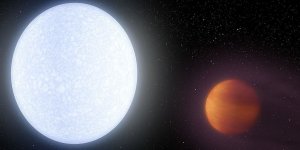| News / Space News |
Does Mars Have Rings? Not Right Now, But Maybe One Day
Saturn has rings, but it's possible that one of our closest neighbors also had rings at one point and may have them again someday.

This sequence of images from NASA's Curiosity Mars rover shows one of Mars' two moons, Phobos, passing directly in front of the other, Deimos. ![]()
That's the theory put forth by NASA-funded scientists at Purdue University, Lafayette, Indiana. They developed a model that suggests that debris that was pushed into space from an asteroid or other body slamming into Mars around 4.3 billion years ago alternates between becoming a planetary ring and clumping together to form a moon.
One theory suggests that Mars' large North Polar Basin or Borealis Basin -- which covers about 40 percent of the planet in its northern hemisphere -- was created by that impact, sending debris into space.
The model suggests that as the ring formed, and the debris slowly moved away from the Red Planet and spread out, it began to clump and eventually formed a moon.
Over time, Mars' gravitational pull would have pulled that moon toward the planet until it reached the Roche limit, the distance within which a planet's tidal forces will break apart a celestial body that is held together only by gravity.
Phobos, one of Mars' moons, is getting closer to the planet. According to the model, Phobos will break apart upon reaching the Roche limit, and become a set of rings in roughly 70 million years. Depending on where the Roche limit is, this cycle may have repeated between three and seven times over billions of years.
Each time a moon broke apart and reformed from the resulting ring, its successor moon would be five times smaller than the last, according to the model, and debris would have rained down on the planet, possibly explaining enigmatic sedimentary deposits found near Mars' equator. (NASA)
YOU MAY ALSO LIKE




